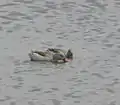Cape teal
The Cape teal (Anas capensis) is a 44–46 cm long dabbling duck of open wetlands in sub-Saharan Africa.
| Cape teal | |
|---|---|
 | |
| Scientific classification | |
| Kingdom: | Animalia |
| Phylum: | Chordata |
| Class: | Aves |
| Order: | Anseriformes |
| Family: | Anatidae |
| Genus: | Anas |
| Species: | A. capensis |
| Binomial name | |
| Anas capensis Gmelin, 1789 | |
Biology

This species is essentially non-migratory, although it moves opportunistically with the rains. Like many southern ducks, the sexes are similar. It is very pale and mainly grey, with a browner back and pink on the bill (young birds lack the pink). The Cape teal cannot be confused with any other duck in its range.
It is a thinly distributed but widespread duck, rarely seen in large groups except the moulting flocks, which may number up to 2000.
This species feeds on aquatic plants and small creatures (invertebrates, crustaceans and amphibians)[2] obtained by dabbling. The nest is on the ground under vegetation and near water.
This is a generally quiet species, except during mating displays. The breeding male has a clear whistle, whereas the female has a feeble "quack".
The Cape teal is one of the species to which the Agreement on the Conservation of African-Eurasian Migratory Waterbirds (AEWA) applies.
Gallery
 Lake Nakuru, Kenya
Lake Nakuru, Kenya Serengeti NP
Serengeti NP Austin Roberts sanctuary, South Africa
Austin Roberts sanctuary, South Africa Darville, Pietermaritzburg, South Africa
Darville, Pietermaritzburg, South Africa Darville, Pietermaritzburg, South Africa
Darville, Pietermaritzburg, South Africa Darville, Pietermaritzburg, South Africa
Darville, Pietermaritzburg, South Africa Darville, Pietermaritzburg, South Africa
Darville, Pietermaritzburg, South Africa Darville, Pietermaritzburg, South Africa
Darville, Pietermaritzburg, South Africa Darville, Pietermaritzburg, South Africa
Darville, Pietermaritzburg, South Africa Darville, Pietermaritzburg, South Africa
Darville, Pietermaritzburg, South Africa
References
- BirdLife International (2012). "Anas capensis". IUCN Red List of Threatened Species. 2012. Retrieved 26 November 2013.CS1 maint: ref=harv (link)
- Hockey, P.A.R., Dean, W.R.J., Ryan, P.G. (Eds). 2005. Roberts – Birds of Southern Africa, VIIth ed. The trustees of the John Voelcker bird book fund, Cape Town.
External links
| Wikimedia Commons has media related to Anas capensis. |
| Wikispecies has information related to Anas capensis. |
